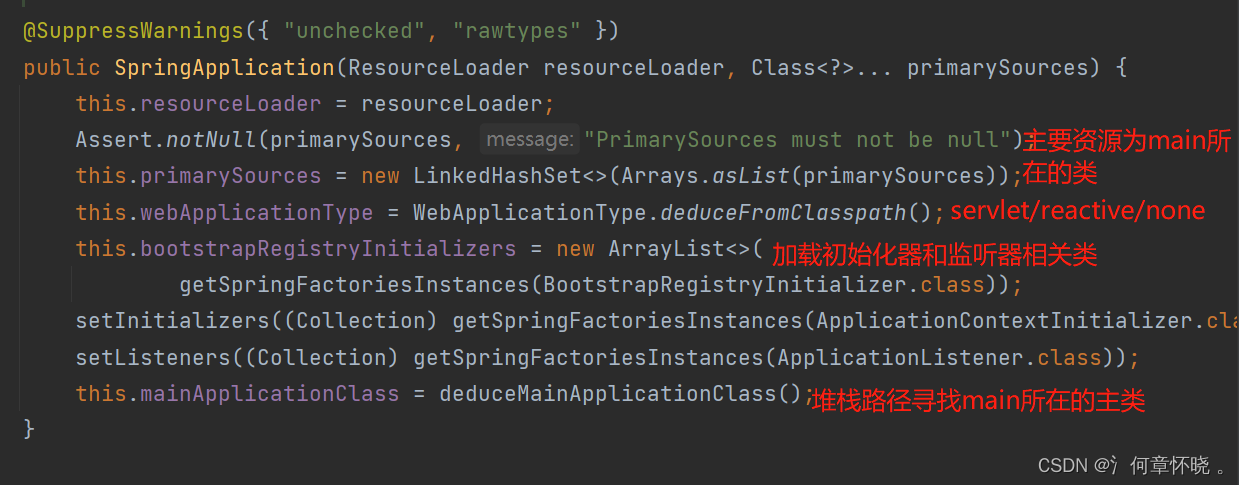
SpringBoot的启动流程可以分为几大部分:
1.创建SpringApplication,加载监听器
2.启动监听器
3.创建创建环境
4.创建容器
5.将环境放入容器中
6.refresh容器
7.启动所有监听器
创建SpringApplication




 构建好SpringApplication执行run()
构建好SpringApplication执行run()

这里是启动的伪代码
public ConfigurableApplicationContext run(String... args) {
//记录开始时间
long startTime = System.nanoTime();
//创建默认引导上下文
DefaultBootstrapContext bootstrapContext = createBootstrapContext();
//声明容器【重要】,spring本身就是容器,针对容器操作
ConfigurableApplicationContext context = null;
//设置一些系统属性 awt
configureHeadlessProperty();
//实例化启动期间的唯一的监听器 SpringAppliationRunListener--> EventPublishingRunListener
Class<?>[] types = new Class<?>[]{
SpringApplication.class, String[].class};
//【此代码是我整合的伪代码,方便观看】加载SpringApplicationRunListener并反射创建
SpringApplicationRunListeners listeners = new SpringApplicationRunListeners(logger,
getSpringFactoriesInstances(SpringApplicationRunListener.class, types, this, args),
this.applicationStartup);
//【此代码是我整合的伪代码,方便观看】启动
listeners.starting(doWithListeners("spring.boot.application.starting", (listener) -> listener.starting(bootstrapContext),
(step) -> {
if (mainApplicationClass != null) {
step.tag("mainApplicationClass", mainApplicationClass.getName());
}
}));
try {
//如启动项目使用命令行,封装为命令行对象
ApplicationArguments applicationArguments = new DefaultApplicationArguments(args);
//根据应用类型创建对应环境 servlet/reactive/none
// 【此代码是我整合的伪代码,方便观看】-----------------------------------------------------------------
ConfigurableEnvironment environment = null;
if (this.environment != null) {
environment = this.environment;
}
switch (this.webApplicationType) {
case SERVLET:
environment = new ApplicationServletEnvironment();
case REACTIVE:
environment = new ApplicationReactiveWebEnvironment();
default:
environment = new ApplicationEnvironment();
}
//【此代码是我整合的,方便观看】 配置环境
//设置转化器和格式化器
if (this.addConversionService) {
environment.setConversionService(new ApplicationConversionService());
}
configurePropertySources(environment, args);
//配置文件,如我们配置的spring.profiles.active dev/daily/online/pre等
configureProfiles(environment, args);
//监听器监听该环境
listeners.environmentPrepared(bootstrapContext, environment);
//将环境绑定到SpringApplication
bindToSpringApplication(environment);
//----------------------------------------------------------------------------------------------
//设置忽略的bean信息
configureIgnoreBeanInfo(environment);
//打印banner
Banner printedBanner = printBanner(environment);
//创建容器
//创建AnnotationConfigServletWebServerApplicationContext容器
//【此代码是我整合的,方便观看】
context = new AnnotationConfigServletWebServerApplicationContext();
//读取
this.reader = new AnnotatedBeanDefinitionReader(this);
//扫描
this.scanner = new ClassPathBeanDefinitionScanner(this);
//设置applicationStartup
context.setApplicationStartup(this.applicationStartup);
//预处理容器,会将环境放入容器
prepareContext(bootstrapContext, context, environment, listeners, applicationArguments, printedBanner);
//刷新这里调用Spring核心源码-->AbstractApplicationContext#refresh
refreshContext(context);
//后处理 空实现 扩展点
afterRefresh(context, applicationArguments);
//计算启动时间
Duration timeTakenToStartup = Duration.ofNanos(System.nanoTime() - startTime);
if (this.logStartupInfo) {
new StartupInfoLogger(this.mainApplicationClass).logStarted(getApplicationLog(), timeTakenToStartup);
}
//启动其他监听器
listeners.started(context, timeTakenToStartup);
callRunners(context, applicationArguments);
} catch (Throwable ex) {
handleRunFailure(context, ex, listeners);
throw new IllegalStateException(ex);
}
try {
Duration timeTakenToReady = Duration.ofNanos(System.nanoTime() - startTime);
listeners.ready(context, timeTakenToReady);
} catch (Throwable ex) {
handleRunFailure(context, ex, null);
throw new IllegalStateException(ex);
}
return context;
}